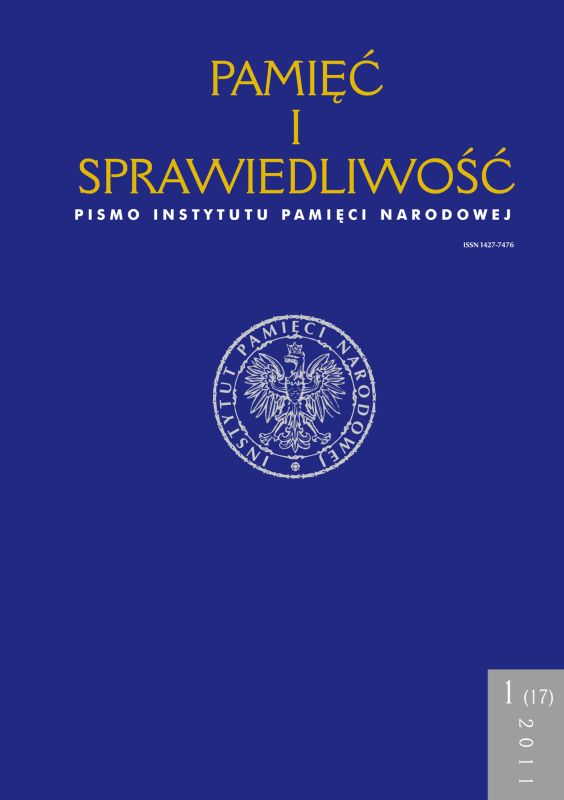Youth conspiracy on Polish territories, 1944–1956
Remembrance and Justice, Vol. 17 No. 1 (2011), pages: 47-74
Publication date: 2011-06-30
Abstract
Between 1944 and 1956 those of young people who expressed their opposition to the communist ideology and atheism present in everyday life and also to the permanent violation of freedom, made a decision to get involved in underground activity. According to the IPN’s records, they formed throughout the country at
least 972 clandestine organizations with 11 thousand members.
Newly created associations referred to various traditions (scouting movement, religion, Home Army, WiN [Wolność i Niezawisłość, Freedom and Independence], BCh [Bataliony Chłopskie, Polish Peasants’ Battalions], NSZ [Narodowe Siły Zbrojne, National Armed Forces], peasant and national movements).
In the youth’s conspiracy work three phases could be distinguished. The first one was a present activity of that time – preparation to the change of political system mainly due to an armed struggle. Young people gained military qualifications and conducted campaign aimed at educating conspiracy members
about the ongoing political situation and at formation of the civil attitude of the local communities (in leaflets – rather than in the underground press – they appealed to people to preserve their national identity, to maintain resistance and to remain independent of official propaganda’s influence). The next
planned phase was to be an direct involvement in military struggle against the enemy, at the side of Polish Army advancing form the West, leading to a restoration of the independence of the country.
There were however two major categories of associations – military and scout. Józef Piłsudski was chosen the ideological patron of some of them, whereas others referred to the national conceptions or even to the theory of socialism simultaneously rejecting its contemporary concept.
They youth conspiracy activists had vision of the Poland’s future. It was to become democratic country, guaranteeing political and economic freedom and civil liberties.
Regardless of the fact that during the first decade of Peoples’ Republic of Poland the youth conspiracy members were not numerous, they were those who – after the defeat of “adult underground” – took over an heritage of an anticommunist
resistance: gros grup (about 66 per cent) was active between the years 1949 and 1953.
Most read articles by the same author(s)
- Jacek Wołoszyn, Dieter Pohl, Bogdan Musiał, [Recenzja] Dieter Pohl, Von der „Judenpolitik” zum Judenmord. Der Distrikt Lublin des Generalgouvernements 1939–1944, Verlag Peter Lang GmbH, Frankfurt am Main–Berlin–Bern–New York-Paris–Wien 1993, ss. 208 i Bogdan Musial, Deutsche Zivilverwaltung und Judenverfolgung im Generalgouvernement. Eine Fallstudie zum Distrikt Lublin 1939–1944, Verlag Harrassowitz, Wiesbaden 1999, ss. 435 , Remembrance and Justice: Vol. 6 No. 2 (2004)
- Jacek Wołoszyn, Reakcja prasy konspiracyjnej na wydarzenia w Zamojskiem z lat 1942–1943 , Remembrance and Justice: Vol. 2 No. 2 (2002)
- Jacek Wołoszyn, The Propaganda Role of the Trials against the Members of Youth Underground Organisations, 1948–1956 , Remembrance and Justice: Vol. 43 No. 1 (2024)
- Jacek Wołoszyn, The Collaboration of the Association of the Polish Youth (ZMP) with the Polish Office of Security (UB) on the Implementation of the ‘Ideological Offensive’ Plans in Youth Communities in Lublin Province , Remembrance and Justice: Vol. 12 No. 1 (2008)
- Jacek Wołoszyn, ‘Live Weapon’ – Undercover Agents in Prison Cells: Secret Collaborators in Prisons and Investigative Jails in the Years 1944–1956 , Remembrance and Justice: Vol. 16 No. 2 (2010)
- Jacek Wołoszyn, Members of the Union of Polish Youth (ZMP) in the Lublin province in relation to the Catholic Church – a contribution to young people’s outlooks , Remembrance and Justice: Vol. 7 No. 1 (2005)
- Jacek Wołoszyn, Participation of Security Apparatus in University Enrolment in Lublin Province in 1947–1956 , Remembrance and Justice: Vol. 11 No. 1 (2007)
 Język Polski
Język Polski
 English
English
 Deutsch
Deutsch
 Français (France)
Français (France)
 Italiano
Italiano
 Русский
Русский


 PDF (Język Polski)
PDF (Język Polski)
